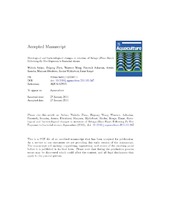Histological and bacteriological changes in intestine of beluga (Huso huso) following ex vivo exposure to bacterial strains
Salma, Wahida; Zhou, Zhigang; Wang, Wenwan; Askarian, Fatemeh; Kousha, Armin; Ebrahimi, Maryam Tajabadi; Myklebust, Reidar; Ringø, Einar
Peer reviewed, Journal article
Accepted version

View/
Date
2011-04-04Metadata
Show full item recordCollections
Original version
https://doi.org/10.1016/j.aquaculture.2011.01.047Abstract
In the present study the intestinal sac method (ex vivo) was used to evaluate the interactions between lactic acid bacteria and staphylococci in the gastrointestinal (GI) tract of beluga (Huso huso). The distal intestine (DI) of beluga was exposed ex vivo to Staphylococcus aureus, Leuconostoc mesenteroides and Lactobacillus plantarum. Histological changes following bacterial exposure were assessed by light and electron microscopy. Control samples and samples exposed only to Leu. mesenteroides and a combination of Leu. mesenteroides and Staph. aureus, had a similar appearance to intact intestinal mucosal epithelium, with no signs of cellular damage. However, exposure of the DI to Staph. aureus and L. plantarum resulted in damaged epithelial cells and disorganized microvilli. Furthermore, 16S rDNA PCR denaturing gradient gel electrophoresis (PCR-DGGE) was used to investigate the adherent microbiota of distal beluga intestine. Several bacterial species were identified by DGGE in the present study that have not previously been identified in beluga.